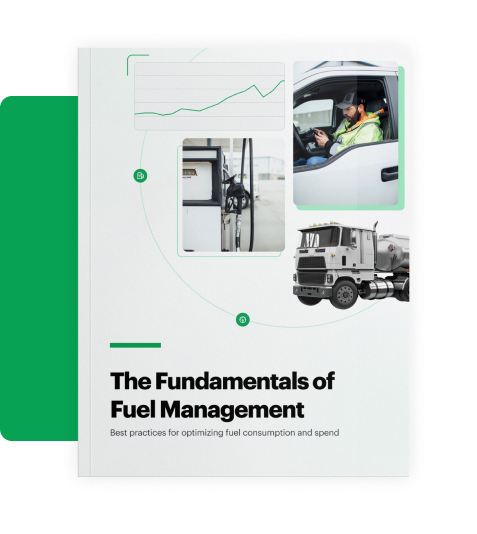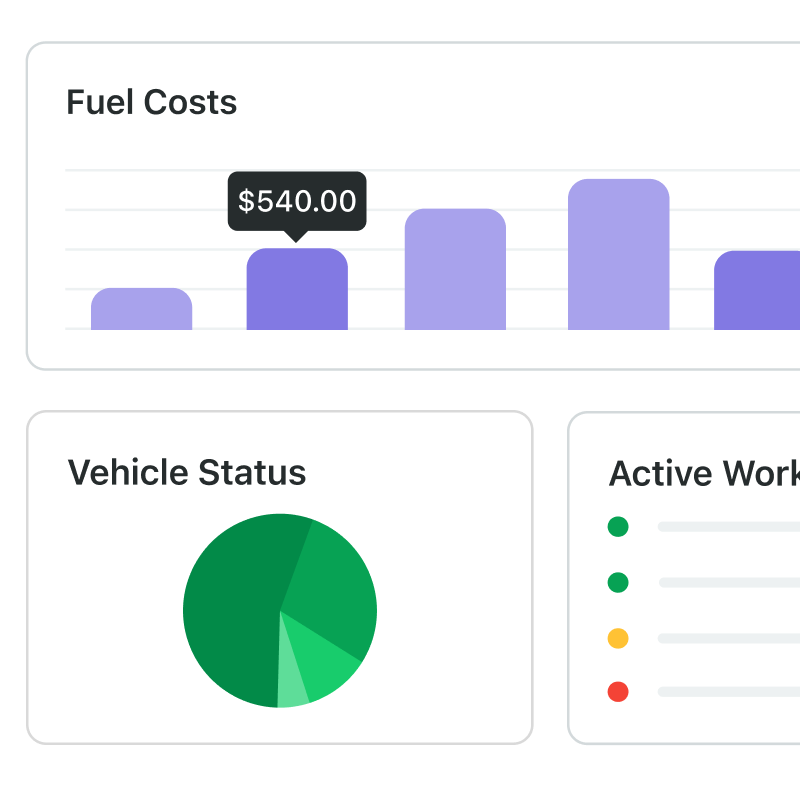Hydrogen Fuel Analysis: A Comprehensive Overview
With a heavy focus on sustainable transportation, the battle between alternative fuels has grown more intense, with hydrogen emerging as a strong — yet often underappreciated — contender. While electric vehicles have garnered significant attention, hydrogen stands as a powerful zero-emission alternative, offering unique advantages.
Nov 9, 2023
10 min read

In a hurry? Jump to the section you’re most interested in:
- A Brief Overview of Hydrogen as an Alternative Fuel
- Why Hydrogen?
- Hydrogen Challenges
- How Hydrogen Stacks Up
- Benchmark Fuel with Fleet Solutions
Despite being an accepted zero-emissions fuel option, hydrogen has been relatively overlooked when it comes to the net-zero goal. This could in part be due to the hype around EVs reaching a fever pitch over the past few years: “In 2021, the number of U.S. registered light-duty electric vehicles (EV) on the roads reached 2.13 million vehicles, a sharp increase from the less than 100,000 EVs on the roads in 2012 [with] BEVs account[ing] for the largest share of registered EVs in the United States, at 65%,” according to the U.S. Energy Information Administration.
Now that there has been a decent amount of various EV types on the road for a number of years, some issues have surfaced, such as severe range reduction in cold climates — that is, if the vehicle will start at all. That, coupled with the lacking infrastructure to support EVs, as well as the high price of energy nowadays, seems like a good indication to broaden zero-emissions fuel research and highlight potential alternatives or even combinations.
While hydrogen was kind of a big deal years ago, interest in it waned with the EV boom. Now, it’s starting to see renewed interest, both with hydrogen combustion engines and in EV fuel cells. Hydrogen Insight explains that “the number of hydrogen fuel cell electric vehicles (FCEVs) on the world’s roads increased by 40% in 2022, compared to 2021, totalling more than 72,000 vehicles, according to figures in the International Energy Agency’s (IEA) new Global EV Outlook 2023 report.” That’s still a long way from matching the number of Li-ion battery-powered EVs on the road, but enough to get a bit of useful data.
It’s important to note that, as with EVs, zero-emissions doesn’t actually mean what the words imply (go figure). But we’ll get into that in a bit. Now, without further ado, let’s dive into hydrogen fuel, including benefits, challenges and just how well it stacks up against both EVs and gasoline and diesel-powered vehicles.
A Brief Overview of Hydrogen as an Alternative Fuel
Anyone familiar with the Hindenburg tragedy — I know, I’m taking us back pretty far here — would be perfectly in the right to ask, “Are hydrogen cars safe?” Especially in the event of an accident, this is a good question. The metal tanks in which hydrogen is stored on a vehicle are designed to withstand significant impact. “Hydrogen is as safe as any other fuel used in a car,” according to Toyota, which has been working on its tank design since 2000. “It’s been used as an energy carrier for decades, and there is a vast amount of cumulative know-how and experience in Toyota and elsewhere to handle it safely.”
But how do hydrogen cars work? As mentioned previously, there are two primary methods of utilizing hydrogen as a fuel: hydrogen combustion engines (HCEs) and hydrogen fuel cell electric vehicles (FCEVs).
Hydrogen Combustion Engines (HCEs)
Using hydrogen in a combustion engine is relatively the same as conventional fuel combustion engines. “Four-stroke hydrogen internal combustion engines operate on the same cycle as regular natural gas engines and have almost the same components — engine block, crank, cylinder heads, ignition system, installation parts, and so on,” explains alternative fuel engine specialist and manufacturer, Cummins. “Diesel engines and hydrogen engines also share similar components. These include an engine block, crank, and installation parts such as mounts and flywheel housings.”
Hydrogen Fuel Cell Electric Vehicles (FCEVs)
FCEVs rely on hydrogen fuel cells, which generate electricity through an electrochemical reaction between hydrogen and oxygen. The resulting electricity powers an electric motor, propelling the vehicle while emitting nothing more than water vapor as a byproduct.
Fleet idling can increase fuel costs by up to 40%
Discover how data-driven fuel management reduces fleet expenses with Fleetio.
Read our whitepaperWhy Hydrogen?
Hydrogen is known as the universe's most abundant element and boasts immense energy potential, capable of transforming the transportation sector. It offers several economic advantages and can be produced from various sources, including water, natural gas and biomass, making it a versatile fuel and energy option. Let’s take a look at some of the benefits of hydrogen as an alternative fuel.
Cost Benefits
Moving to hydrogen could potentially reduce fuel costs down the line, but how much is hydrogen fuel currently? “A kilogram [of hydrogen] is equivalent to two gallons of fuel as far as energy [and comes in at about] $13 to $16 per kilogram – this is about the same cost of gas today,” according to the Department of Energy. “The range from that amount of H2 depends on the vehicle. Some are able to travel more than 300 miles on a complete refilling of H2. The fuel economy is around 70 miles per gasoline gallon equivalent (MPGe).” On the plus side, hydrogen production costs have been steadily decreasing, enhancing its competitiveness.
Environmental Benefits
One of the most compelling advantages of hydrogen is its environmental credentials. When burned or used in fuel cells, hydrogen produces little to no greenhouse gasses or harmful tailpipe emissions. Instead, it generates only water vapor in the case of hydrogen fuel cell electric vehicles (FCEVs), and produces a smidgeon of nitrogen dioxide in the case of hydrogen combustion engines (HCEs). As with conventional EVs, however, just because the tailpipe emissions are greatly reduced, it doesn’t mean that producing the energy source is free of negative environmental impacts. This is why carbon intensity measurements have expanded from tank-to-wheel to well-to-wheel.
“Hydrogen production can have a large environmental impact depending on how it is produced. Today, close to 95 percent of hydrogen production is from fossil fuels like natural gas and coal. As a result, we emit 830 million tonnes of CO2 each year to produce 74 million tonnes of hydrogen,” according to MIT Climate Portal. “A wide range of processes can be used to produce hydrogen [but] there are two ways to move toward cleaner hydrogen production that are cheap enough to pursue on a large scale in the near future. One is to combine fossil fuel-based hydrogen production with carbon capture and storage. The second is to use water electrolysis powered by electricity from low-carbon sources, such as renewable energy or nuclear power.”
Implementation Benefits
The biggest implementation benefits with both HCE and FCEVs is that, with the right mechanics and know-how, conventional internal combustion engine vehicles can be converted to run on hydrogen, and for cheaper than the capital and/or conversion costs of EVs. “The conversion of an internal combustion engine car into a fuel cell vehicle would be about half the cost of converting the same car to become battery electric,” according to Hydrogen Fuel News. “Among the main reasons for this is that the battery required in the FCV is about a tenth the size of what is needed for a battery electric car. The conversion costs can be assumed to be similar to what it would cost to convert to propane or liquefied petroleum gas (LPG).”
Performance Benefits
HCE vehicles deliver fast refueling times, often comparable to traditional gasoline and diesel vehicles, while both HCEs and FCEVs purportedly exhibit higher efficiency and provide longer driving ranges compared to many battery electric vehicles. That said, there are a lot of factors that contribute to efficiency and range, including vehicle type/size and application. However peer-reviewed research published in 2022 does suggest that “hydrogen has a high octane rating, high calorific value and because of this, it is [a] very attractive fuel for internal combustion engine[s].”
Hydrogen Challenges
As with anything, hydrogen comes with its own set of challenges, and one of the most significant is fuel induction. In the aforementioned research paper, several methods of induction were compared. “There have been [continuous] improvements on hydrogen engine[s] for performance and emission,” according to the study. “Hydrogen induction methods used in internal combustion engines [include:] carburetor with gas-air mixer, continuous manifold injection (CMI), timed manifold injection (TMI), low-pressure direct cylinder injection (LPDI) [and] high-pressure direct cylinder injection (HPDI).” Of course, these induction methods all have their own distinct advantages and disadvantages, so if you’re interested, I encourage you to pop over to the study linked in the section above to learn more.
Another challenge when it comes to hydrogen is infrastructure and availability. While hydrogen is in abundance, pure hydrogen is not, hence the production methods and costs (both to the environment and your wallet). However, bolstering the infrastructure for hydrogen is less involved or costly than for… say… EVs. “As of 2023, there are 59 open retail hydrogen stations in the United States,” according to the Department of Energy. “Additionally, there are at least 50 stations in various stages of planning or construction. Most of the existing and planned stations are in California, with one in Hawaii and 5 planned for the northeastern states. As the market expands, hydrogen fueling stations will be matched with vehicle rollout as both grow together. Customers are expected to have similar experiences at hydrogen fueling stations as at gasoline stations, with most hydrogen dispensers being added at existing gasoline stations.”
Now, I will say that building infrastructure in conjunction with a new or less used fuel type is not quite proactive and puts us in the same situation as lacking the infrastructure for EVs, but overcoming issues related to hydrogen fuel induction, ensuring the availability of adequate resources and addressing safety concerns are all vital steps toward realizing its potential as a widely adopted alternative fuel.
How Hydrogen Stacks Up
We’ve covered a lot of ground, but somehow we’re still at a stalemate for best-in-show when it comes to alternative fuels, so let’s take a look at how hydrogen (both HCEs and FCEVs) affects overall costs from a high vantage point.
Road Wear
In an article in Clean Technologies and Environmental Policy, a study was conducted to measure road wear caused by the increased payload that comes with EVs. While light-duty vehicles had negligible impact on road wear, the study found that when examining four different scenarios (all battery, all hydrogen, all combination and current [internal combustion engine vehicles]) the results were clear: “We find 20 - 40% additional road wear associated with battery vehicles compared to internal combustion engine (ICE) vehicles; hydrogen leads to a 6% increase. This is overwhelmingly caused by large vehicles – buses, heavy goods vehicles.”
Road wear impacts everyone, as poor road conditions increase fuel consumption and wear brakes, tires and suspension faster.
Infrastructure
One key differentiator between hydrogen, ICE and EV infrastructure is availability. While the charging infrastructure for EVs is continually improving, hydrogen refueling stations are still in the early stages of development, though there are several thousand around the globe. The expansion of this infrastructure is vital for the widespread adoption of hydrogen vehicles, and takes less money, time and effort than developing the EV infrastructure.
Upfront Price
Electric vehicles typically have a lower upfront cost compared to hydrogen FCEVs and even HCEs. However, the price difference may diminish as technology advances and production scales up, which is currently taking place. Conversions are the more cost effective alternative.
Lifetime Price
When considering the lifetime cost of ownership, including maintenance and refueling costs, hydrogen vehicles can compete with or even outperform electric vehicles and are seemingly at parity with ICE vehicles. Furthermore, advancements in hydrogen storage technology may further level the playing field.
Emissions
Both hydrogen and EVs offer significant reductions in emissions compared to ICE vehicles; however, hydrogen may hold a slight advantage due to its faster refueling times and longer driving ranges, potentially leading to more widespread adoption.
Benchmark Fuel with Fleet Solutions
Before taking any steps toward alternative fuel adoption, it’s important to set a benchmark for current fuel use/type, price and actual consumption. This can either be done manually or with a fuel monitoring system. Using fleet tech like fleet management software can improve data collection and analysis, giving you data-driven insights from which you can make educated decisions.
In the ongoing quest for zero-emission transportation, hydrogen's potential as a robust alternative fuel source should not be underestimated. Its environmental, cost and performance benefits place it firmly in the race to reduce the environmental impact of the transportation sector. While obstacles remain, addressing these challenges could unlock hydrogen's full potential and usher in a new era of clean, sustainable mobility.
Make fuel data management simple with Fleetio
Analyze fuel mileage, costs, efficiency & fuel card misuse in one platform.
How does it work?
Senior Fleet Content Specialist
As a Senior Fleet Content Specialist at Fleetio, Rachael Plant uses her near decade of industry experience to craft practical content aimed at helping fleet professionals tackle everyday challenges with confidence.
LinkedIn|View articles by Rachael PlantReady to get started?
Join thousands of satisfied customers using Fleetio
Questions? Call us at 1-800-975-5304

